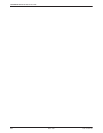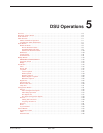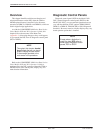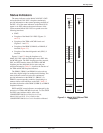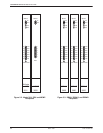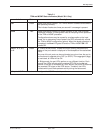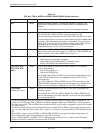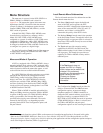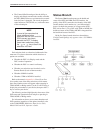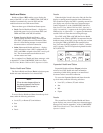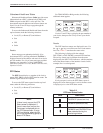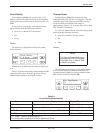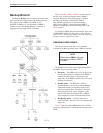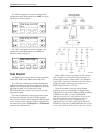
DSU Operations
5-73610-A2-GB41-60 March 1999
Menu Structure
The menu tree is accessed via the DCP (SDCP for a
DBM-V, DBM-S, or DBM-D) and is shown in
Appendix A. The menus that appear in the menu tree
depend upon the DSU’s function within the network
(control or tributary), the hardware options that are
installed (DBM, TDM or MCMP, LPDA*), and the
DSU’s mode of operation.
A Model 3610 DSU-TDM or DSU-MCMP comes
from the factory configured as a tributary, while a
Model 3611 DSU-TDM or DSU-MCMP comes
configured as a control. In addition, a DSU-TDM comes
configured for TDM mode, while a DSU-MCMP comes
configured for MCMP mode. The mode of operation can
be changed to disable the TDM or MCMP circuit card or
to configure it to operate as a digital bridge.
Use the Configuration (Confg) branch of the menu tree
to change these settings and customize the DSU-TDM’s
or DSU-MCMP’s configuration.
Menus and Mode of Operation
A DSU not equipped with a TDM or MCMP is always
operating in Basic mode, whereas a DSU equipped with a
TDM or MCMP can operate in one of several modes. The
mode of operation affects the menus that appear, as well
as the selections that are available within the menus.
For a DSU-TDM, the following selections are available
through the MUX path of the Configuration branch:
TDM, CBrdg (central-site bridge), EBrdg (extended
bridge), and None. For a DSU-MCMP, the following
selections are available: TDM, MCMP, CBrdg, EBrdg,
and None. Selecting None disables the TDM or MCMP
circuit card; the unit operates as though there is no TDM
or MCMP installed in the DSU.
When a TDM or MCMP is installed and enabled, the
CBrdg and EBrdg selections permit the TDM or MCMP
to operate in Bridge mode. For TDM, MCMP, or Bridge
mode, a port number (Prt1 through Prt6) must be
specified before issuing some commands. The results
returned by the DSU may vary depending upon the
operating mode (MUX Funct configuration option) and
the port selected.
Local/Remote Menu Subbranches
The Local branch menu has five subbranches and the
Remote branch menu has four:
• The Status (Stat) branch reports the health and
status of the DSU and its options, the DTE
interface, the DSU’s identification information, the
status of the connected DTE’s EIA-232 and V.35
interfaces, and, if there is a dialed PSTN
connection, the quality of the PSTN circuit.
• The Backup (Bckup) branch controls the operation
of the dial backup feature. Through this branch, the
the digital bridge or aggregate switch is activated or
deactivated. This branch can only be accessed from
the Local branch.
• The Test branch provides extensive testing
capabilities for the DSU, the DDS circuit, the
DBM, and the backup circuit if there is a backup
call in progress. This branch also provides test
capability for TDM or MCMP circuitry and the
additional ports.
NOTE
If the Test branch
does not
appear, the DSU is in Display
mode; values can be read but not
changed. Only authorized
persons can change configuration
option values for the DSU.
Contact your System
Administrator for further
information.
• The Configuration (Confg) branch provides the
ability to customize DSU and DBM software
configuration options, to enter and change
telephone numbers (if a DBM is installed), to
change the DSU network address, and to specify
the protocol used by a connected NMS. For a
DSU-TDM or DSU-MCMP, the mode of operation
(TDM, MCMP, Bridge, or Basic) is selected, and
the TDM or MCMP port and port speed
configuration options are also set using this branch.
*The SNA Diagnostic Interface option (LPDA on the menu tree) for multipoint applications is discussed in this guide.
Refer to the COMSPHERE 3600 Series Data Service Units, Models 3610 and 3611, Dial Backup Module and SNA
Diagnostic Interface Options, Applications Guide for point-to-point applications and the configuration options unique to
those SNA Diagnostic Interface (LPDA-2) applications.




